The History Of SEAT Ibiza

The SEAT Ibiza is a supermini manufactured by the Volkswagen Group and sold under the SEAT marque. The Ibiza spans four generations and is still in production. It has been available in either three- or five-door hatchback variants; since 1993, saloon, coupé and estate versions are sold as the SEAT Córdoba.
The Ibiza Mk1 (codenamed 021A) was based on the SEAT Ronda, in turn derived from the Fiat Ritmo, with a powertrain which had been developed in collaboration with Porsche. This was the first SEAT which did not share any external body panels with any Fiat model, having been designed by Giorgetto Giugiaro. This version, while it established the now classic Ibiza shape, was advertised as having "Italian styling and German engines".
It was known for having a rather quirky interior instrument layout, marked by a lack of control stalks. The indicators were operated by a rocker-switch and the headlights by a sliding switch.
In terms of size, it was larger than most superminis like the Ford Fiesta and Fiat Uno, but smaller than any small family car such as the Ford Escort and Volkswagen Golf. Styling was fairly imaginative and interior space was good, but the Ibiza was let down by suspect build quality, heavy steering and doubtful reliability.
SEAT also produced a saloon model based on the same platform, the SEAT Málaga.
In the UK, sales couldn't hope to compete with Ford, Vauxhall and Rover (or even imported brands like Volkswagen and Fiat), but the car sold well among buyers who were more interested in budget buys from the likes of Hyundai and Škoda. The Ibiza's moderate sales success gave the marque a decent platform to build on as it looked to increase sales throughout the 1990s.
In 1999 the design was bought by Chinese automaker Nanjing and was redeveloped into the Nanjing Yuejin Soyat.
This model (internal type number 6K) was based on VW's A03 platform also used by the Typ 6N Polo (Mk3). Available in three and five-door models, the saloon/ coupe variant was known as the Córdoba and the estate was known as the Córdoba Vario.
Mk2 (6k) Facelift 1996-1999
The Ibiza had a small facelift in 1996 which included changing the general aesthetics of the car by adding smoother bumpers and changing the grill and headlight setup. Other than changing the appearance of the car the running gear changed through the addition of the 2.0 16v engine and the demise of the 1.8 16v engine, both engines previously in the Volkswagen Golf Mk3.
Second generation (facelift) (1999-2002)
The Ibiza Mk2 facelift (typ number 6K2 or 6K GP01; sometimes referred to in the UK as the "Mk3") was the second Ibiza to be produced under Volkswagen Group management and used the underpinnings of the revised Polo Mk3 (actually, the underpinnings of the Volkswagen Golf Mk3). It suffered a little from brand identity issues on release. Originally seen as a cheap VW, the launch of the Cupra models and rallying success gave it a much stronger sporty image, which aligned with Volkswagen Group's acquisition of Škoda Auto as a budget brand.
The Ibiza's 1.0, 1.4, 1.6 and 1.8-litre petrol and 1.9-litre TDI and SDI Diesel engines were the same as the Polo's. The Ibiza's running gear was also used in the SEAT Córdoba saloon, estate and coupé.
Under Volkswagen's ownership, Seat was marketed as a sporty and youthful brand whose cars were sold at competitive prices. The original Ibiza's problems with bad build quality and unreliability were rectified, as the Ibiza proved itself to be one of the best built and most reliable small cars in Europe.
The Ibiza was also produced in South Africa as the Volkswagen Polo Playa and also in Argentina.
It also introduced a powerful hot hatch dubbed Cupra and equipped with a turbocharged 1.8-litre engine, followed by the 1.8-litre turbocharged Cupra R which was available in very limited numbers only (75 in the UK). The main difference between the two was suspension, Brembo 4 pot brakes and a power upgrade from 156bhp to 180bhp on the Cupra R model.
By the time production of the second generation Ibiza/ Córdoba ceased during 2002, the range had established itself as one of the most popular superminis in Europe of the past decade.
The Ibiza Mk3 (codenamed Typ 6L, and sometimes referred to in the United Kingdom as the Mk4) is the third model to be produced under Volkswagen Group management and is a much more focused car.[clarification needed] Built on the same PQ24 platform as the Typ 9N Polo, it is intended to have a sporty, performance image, and was styled by the Italian designer Walter de'Silva. The model line up includes two hot hatch variants, the Ibiza FR and Cupra. These compensate for the lack of Polo hot hatch variants (the Polo GTI wasn't launched until 2006).
The more aggressive styling has boosted this model ahead of the family-friendly styling of the Polo. It is also the largest Ibiza to date, with room for five adults, and a spacious, if rather short, boot. The standard trim level on this model is noticeably higher than previous models.
This is regarded by some magazines to be the best supermini, with What Car? magazine calling it their best supermini for three years in a row.
The 2006 model made slight aesthetic changes to both the interior and exterior, but keeping it very similar to the 2002 original model. It also introduced engines with increased power (1.2 12V and 1.4 16V) and a new 1.4 litre TDI diesel version. The Sport used the revised 1.9 litre PD TDI diesel engine with 105bhp (previously 130). The FR and Cupra TDI versions use a 1.9 litre Pumpe-Düse Diesel engine with respectively 130 and 160 bhp (the latter is a development of the 150bhp unit used in the Golf GTI and Leon FR, modified by Seat Sport to improve breathing, giving one of the highest specific power outputs for a two-valve diesel under two litres).
SEAT launched a new advertising campaign to follow the new model with the slogan "The rituals are different, the spirit is the same". It depicts four individuals each on a different colored SEAT Ibiza, performing different activities inside their car before actually starting it. The campaign sends a message that all people are different, but inside we all have a "sporty spirit".
The fourth generation of the Ibiza (Typ 6J), styled by Luc Donckerwolke, was previewed at the 2008 Geneva Motor Show in the form of the Bocanegra concept car. The new model is now on sale in 5-door format.. Three door variants are marketed as the Ibiza SportCoupé or Ibiza SC. Ibiza Eco-motive, FR and Cupra models are also expected.
The new Ibiza Cupra model is powered by a 180 bhp twin-charger (Turbo and Supercharger) 1.4 TSI petrol engine and has a 7-speed DSG gearbox.
From Wikipedia, the free encyclopedia
More About SEAT Ibiza

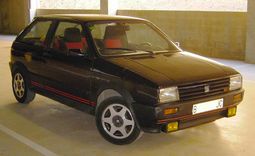
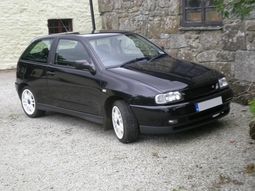
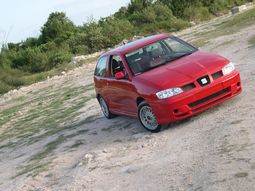
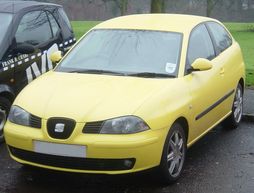
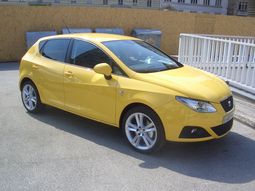
|